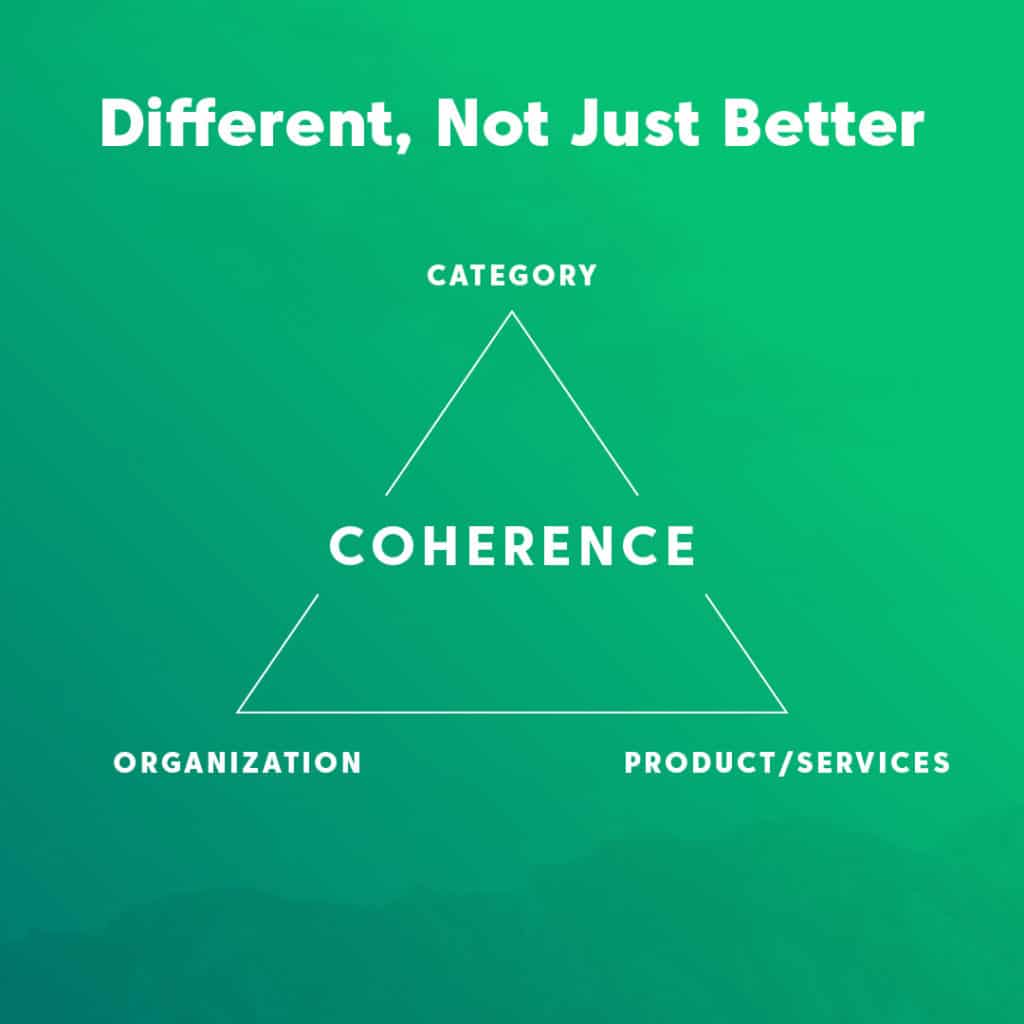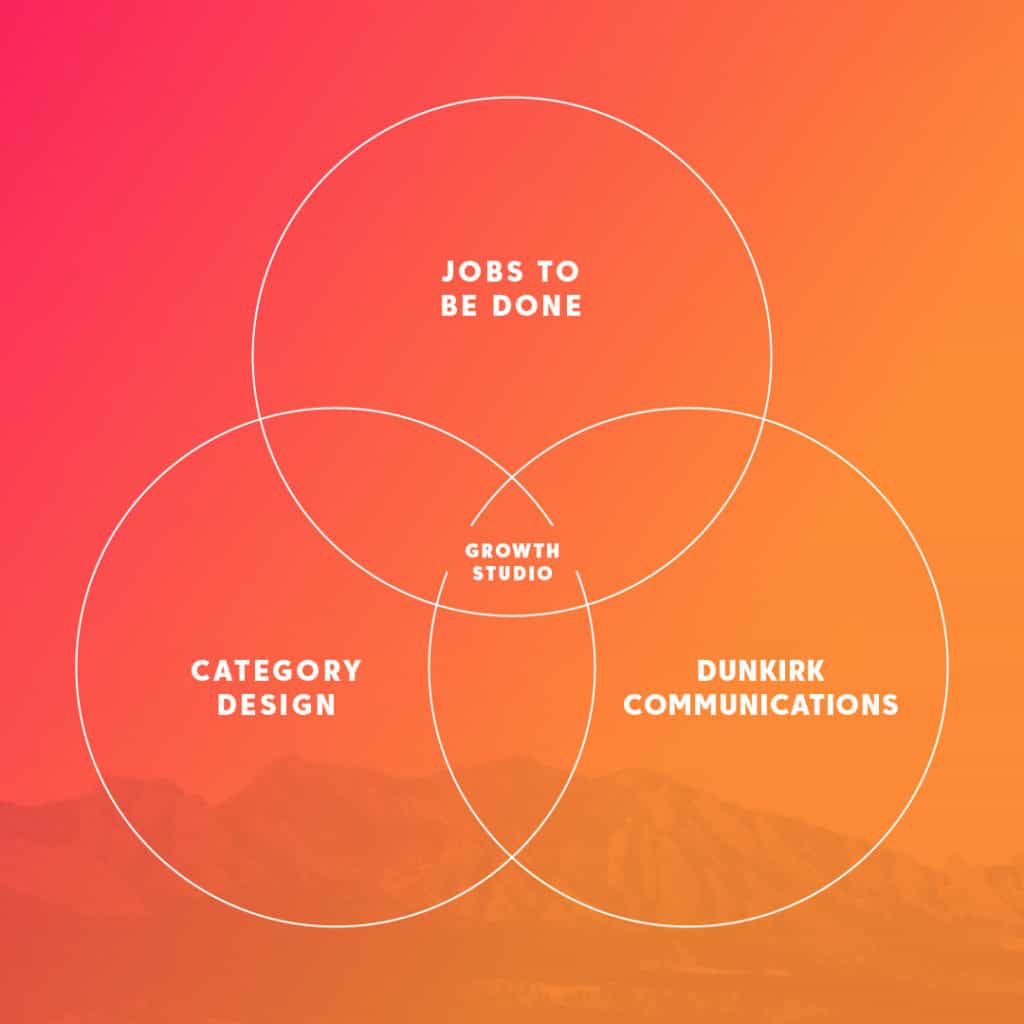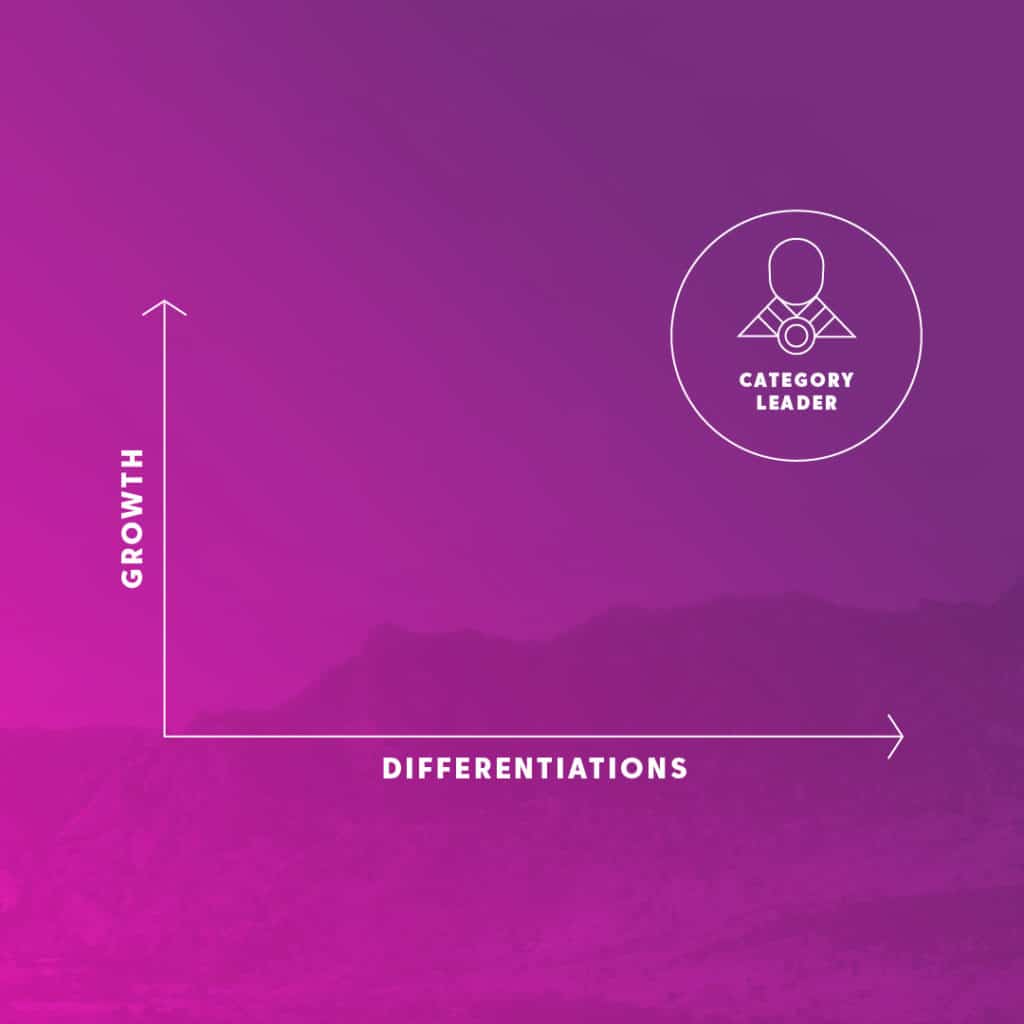What Is a Growth Studio?
As a “growth studio” is relatively new, we’d like to invite your questions and comments to build more education and conversation around this emerging category.
The term “growth studio” draws its meaning and inspiration from five concepts:
- Evolution. Growth is synonymous with evolution: what got you here won’t get you there.
- Art. Studios make space for expression, calling for what’s imagined, inspired, and original.
- Science. Laws of nature manifest in our work and are observable in our learning.
- Philosophy. Curiosity connects human thought with the way our world works.
- Practice. The process pulls insights into action, providing order without limiting creativity.
What is a growth studio?
A growth studio’s purpose is to guide the strategy and action for businesses that wish to become category leaders in their industries.
There are two key objectives a growth studio provides for its customers:
- Building conditions by which category leadership and high growth are most likely to occur.
- Increasing an organization’s ability to operate with coherence across brand, marketing, and sales efforts.
This latter objective is guided by the Coherence Method, understanding coherence is what provides leading organizations with the clarity, capacity, and unity required for high growth.
Lesson 1 from a Growth Studio: Coherence Is What Provides Leading Organizations With the Clarity, Capacity, and Unity Required for High Growth.
Who is a growth studio?
A growth studio is an intentional group of professionals, loosely yet coherently structured around deep expertise across brand, marketing, and channel/sales areas of a business. Although other types of firms may identify as such, the growth studio category is in partial response to common limitations within marketing agencies, PR groups, and consultancies.
As with any emerging category in the market, growth studio use cases will continue to gain traction, most likely finding new relevance in areas of M&A, product launch initiatives, and business accelerators.
Why do growth studios exist?
A growth studio’s guiding principle is that organizations must whole-heartedly pursue being different, not just better.
Lesson 2 from a Growth Studio: Organizations Must Wholeheartedly Pursue Being Different, Not Just Better.
Consistent with the fundamentals of category design, seminally defined in Play Bigger, companies that are category leaders in their industry tend to be radically different from their competitors. Holistically, their category, organization, and product/service offerings are better positioned for quantum levels of growth.
While many companies say they are focused on this kind of growth, their actions are often inconsistent or misdirected. As a result, incoherence is experienced within specific areas of the business ecosystem, which negatively impacts the way a company operates, markets sells, and meaningfully connects with the rest of the world (customers, partners, investors).

Although the impact represented by the figure above may present across all areas, the focus of a growth studio is not on organizational development or product innovation. Rather, its focus is on “Category” with an emphasis on how an organization’s brand, marketing, and sales are operating with, and building, coherence.
All the software, big data, and expert resources available to CMOs and business leaders were supposed to have made growth come easier. But with everyone accessing the same, and believing the same, they all eventually do the same.
The herd mentality that ensues inevitably positions organizations to look for what’s safe, and where others have already appeared to succeed. Advertising is the default example with plenty of success stories and no shortage of research showing how digital media budgets continue to increase.
Of course, there is also no shortage of case studies, which deliver extreme examples of success and are not an accurate picture of what most companies actually experience. As AI and optimization efforts further support the promise of iterative and predictable growth, it’s no wonder an organization’s focus is frequently limited to tactical (ad/sales) channels.
That’s the race to being better, not different: going after the same demographics with similar messages on a select, few channels. It’s chasing incremental value that, at some point, leads to exhaustion. Every time an algorithm changes, you need to relearn it. Every time a new competitor enters the market, you need to up the spend. “Best practices” become basic practices.
Lesson 3 from a Growth Studio: Software, Big Data, and Best Practices Only Take You So Far Because When Everyone Has Access to the Same and Believes the Same They All Eventually Do the Same
A growth studio goes further, finding new energy and opportunity through an emphasis on being different. No, not everyone can be the category leader, but the pursuit can lead to exponential levels of growth that have a lasting impact. Growth from essentially defining your own category; from deeply understanding your customers, to knowing the true difference of your brand, and its unique opportunity to succeed.
How does a growth studio work?
Of course, there is no single formula for achieving high growth, and the aggregate odds of actually being the category leader within an industry are extremely low.
The hypothesis follows that if the ultimate objective (being the category leader) isn’t achieved, the work conducted in pursuit of it may be highly and uniquely valuable, even to the extent of discovering and acting on unforeseen opportunities that advantageously set you apart.
The conditioning for category leadership is what a growth studio is after: recognizing outcomes from higher levels of clarity, possibility, and decision-making. The “how” in all this is applied through a combination of principles and practices that first tap the genius of an organization’s leadership and customers (not the genius of the studio or any other vendor/partner).
On the leadership side, for example, category design practices are used to help create a truly unique point of view, with an eye on how to condition the market by first marketing the problem, as opposed to just the features and benefits of the solution.
This is accompanied by Dunkirk Communication modeling, which is specific to team effectiveness and the transfer of wisdom across (brand/marketing/sales) areas of a business that are typically siloed.
The connecting linchpin is a deep, nearly obsessive, understanding of customers. For this, a growth studio uniquely applies the Jobs to Be Done theory, maximizing the value of qualitative data for knowledge beyond what any survey, focus group, persona profile, big data research, or customer journey document could ever offer.

Although “Jobs theory” is birthed from a focus on product innovation, a growth studio embraces its insights and methods from a messaging and content creation perspective. Why? Because Jobs theory gets to the heart of why people buy. Communication (content) that’s derived from comprehensively answering that question is essential to conditioning for high growth.
The mission of a growth studio in this context is to build a foundation of understanding to support the actions and coherence needed for substantial progress.
This foundation relies on:
- Quantitative data, paired with external trends and company-specific research
- Category design insights from C-suite and internal teams
- Customer knowledge from an ongoing practice of Jobs to Be Done interviews
A growth studio tests and refines this foundation by continuing to build upon it. That includes pulling insights through to action across brand, marketing, and channel efforts. Pulling through to action is the first proof-positive of building coherence.
When coherence is present; the way in which decisions are reached, resourced, communicated, and measured requires less effort. That means gaining a greater capacity for creativity, as opposed to operational administration, and has very little to do with the number of hours people work on any given day. In other words, more people are more engaged with more of what matters.
The Dunkirk Communication Model serves as the basic tool to check this, helping individuals communicate what matters most, while also asking themselves how they will apply the information they have to think and act differently.
On the surface, much of the output resulting from this work can reasonably be labeled as “branding,” “search marketing and advertising,” “sales,” etc. The growth studio difference is how that output is generated, and more importantly, how effective it is as a result.
As an example, consider how a competent marketing or ad agency with strong creative and media experience goes about creating a multi-channel marketing campaign. Assume they’re given a specific set of goals or objectives. A high-level summary of how most agencies deploy their process includes some variations of:
- Discovery: this might include web/social analytics, purchased 3rd party research, media/ad targeting data, audience/persona descriptions, social listening, surveys and/or focus group data, and development of an initial document or brief to drive the next steps
- Ideation: the act or process of brainstorming, coming up with “the big idea” (or maybe a ton of smaller ideas working together), vetting, iterating, creative/technical brief development, pitching
- Implementation and/or execution: bringing creative concepts and messaging to life, transforming ideas into action, managing the plan and associated strategy within various channels, making adjustments in response to results along the way
- Measurement: data collection and analysis, tracking of key performance indicators, dashboard management, feedback loops, monitoring, and post-campaign reporting
Agencies are typically known for heavily weighing in on one of two sides: art or science. Some are capable of both, but the point is, when viewing the bullets above, the bottom three are where most of the emphasis lies.
“Discovery” is often the red-headed stepchild. Why? Maybe it’s because it frequently relies on third-party data everyone can get their hands on so it’s perceived only as basic, precursory background. Or, maybe related first-party data, surveys, and focus group information is too often disconnected or out of context with the objective of any given campaign.
Sometimes, “what research provides,” is simply too open-ended. On the other hand, it may also be too limiting. For example, you may be excited by being given 1-3 key insights from the discovery process to help guide your thought and action for campaign creation. Or, you may find they act as more of an anchor than a helper to the creative process.
Especially when there is good creative tension, insights tend to get questioned. How were these insights generated? Do we believe them? Suddenly, there are more questions about the insights, but time is running out. "The campaign needs to get going." "Let’s just roll with what we have.”
The growth studio point of view requires a far heavier focus on discovery, not just a better way of getting to insights, but a different one. Beyond the rigor attached to methods already referenced, is the participation (in discovery) of relevant experts that are not usually involved with this kind of work.
Think branding, creative, media, advertising, and solutions delivery experts participating in discovery processes with you and your customers as opposed to a few of those experts getting a handoff — maybe in the form of a deck, document, presentation, brief, etc — from an individual or separate insights group working in somewhat of a vacuum.
The participation doesn’t stop there, nor is it limited to yet another brainstorm that eventually shoehorns ideas into a Paid / Owned / Earned / and sometimes Social framework. Without going further down the rabbit hole of this example, the point is that different results are most likely achieved with different methods.
Inherent to the process itself is a question every studio participant must answer: “How is the unique information I have helping me to think differently so I can do differently?”
Lesson 4 from a Growth Studio: You Add Value by Asking: ‘How Is the Unique Information I Have Helping Me to Think Differently So I Can Do Differently?'
The “final act” or ongoing engagement a growth studio strives to provide is one of accountability toward the pursuit of category leadership and high growth. This may include:
- Monthly or quarterly check-ins on progress and recommendations across brand, marketing, and sales efforts with a diverse group of studio experts
- Participation in the Coherence Marketing Health Index designed to help benchmark, measure progress, and prioritize work needed
- Data warehousing and analytics dashboard efforts
- Custom workshops and program development
- Quarterly or bi-annual customer interviews and market updates
As the above might indicate, a growth studio is focused on a lasting impact as opposed to an overnight success, believing the long game is where category leadership is won. However, it is also prepared and expectant for a range of problems across brand, marketing, and sales that may require immediate solutions. As a result, it frequently operates with two strategic timelines created to work in parallel (one of which includes work within a 30-60-90 day period).
What does the future for growth studios look like?
While growth studios will continue emerging independently in the future, more organizations will invest in building their own internally.
How is that a reasonable prediction? For one, the United States is a nation of extreme business creation. Despite the decline of startups since 2006, there remain over half a million new businesses created every year in the U.S., and the SBA reports that 50% will still be open five years from the time they started.
But this isn’t just about bootstrapped startups. The fact is, we are experiencing a cultural evolution, evidenced in larger companies with their own entrepreneurial and startup-minded initiatives. It’s no wonder business accelerators (once more commonly known as startup incubators) like Techstars have added new service portfolios targeted at corporate partners.
For example, large organizations can work with Techstars to further develop their own internal, entrepreneurial teams or go in a completely different direction by having direct mentor and investment access to a network of outside startups relevant to their industry.
The point in all of this? There's already an increasing need to proactively develop and protect an organization’s position as a differentiated business entity. The more that difference matters, the more opportunity there is for high growth. Together, the market crowns the category leader.

With the odds of achieving the ultimate prize being so low, how will businesses reason the pursuit of category leadership as a worthy investment? Again, the by-product of this pursuit helps establish conditions where high growth is most likely to occur, and differentiation is not mutually exclusive with high growth. For category leaders, they work together.
As an organization gets closer to category leadership, customers tend to see fewer options to choose from. Many alternatives to whom the market recognizes as the category leader often look dated or unintelligent.
Lesson 5 from a Growth Studio: As an Organization Gets Closer to Category Leadership, Customers Tend to See Fewer Options to Choose From. Many Alternatives to Whom the Market Recognizes as the Category Leader Often Look Dated or Unintelligent.
Because this is not an all-or-nothing destination, organizations will take the journey by developing their own, internal growth studio that is consistent with the way they have been building internal marketing, social, and PR teams for many years.
Of course, bold predictions for the future are never wrong at the moment they are made. What do you think of the growth studio concept? Do you agree that organizations can intentionally condition themselves for high growth, even beyond the predictable growth models relating to common practices and marketing optimization work?


Comments